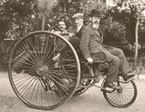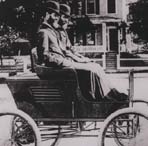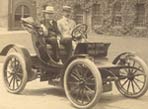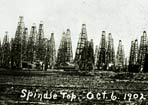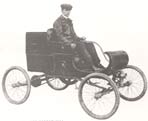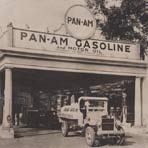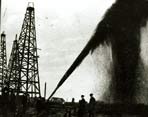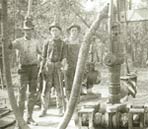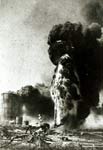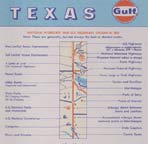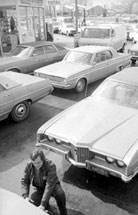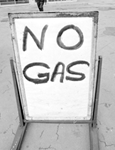
The Automobile and the Environment in American History
Energy Use and the Internal Combustion Engine
The first gasoline-fueled, four-stroke cycle engine was built in Germany in 1876. In 1886, Carl Benz began the first commercial production of motor vehicles with internal combustion engines. By the 1890s, motor cars reached their modern stage of development. In fact, the models of that decade were so successful that there has been no fundamental change in the principles of the ordinary automobile engine since that time.
It took several more years for the internal combustion engine to sweep the American market, however. General conditions, such as the expansiveness of the nation, the lack of decent roads, and the relatively well-developed urban transit system, worked against adoption of any and all motor vehicles for a time. Mass production of gasoline-powered cars, however, brought to the market a vehicle that was modestly priced, easy to maintain, relatively fast and powerful, able to travel long distances, and fueled by a cheap, abundant, widely-available source of energy.
Before the era of the Model T, gasoline-fueled vehicles had stiff competition from steam-driven and electric cars. In fact, of the 4,200 cars built in the United States in 1900, only one-fourth employed internal combustion engines. And of the approximately 8,000 automobiles on the road, most were steam-driven. Steam had been used as early as 1769 to power a road vehicle. French Army engineer Nicholas Joseph Cugnot designed a three-wheel truck for hauling artillery. Experimentation with steam-powered vehicles began in the United States in the 1780s primarily in the Northeast. Into the nineteenth century, however, steam-engine technology tended to focus on locomotives rather than cars.
Particularly noteworthy in the United States were steam cars produced by twins Francis E. and Freeland O. Stanley, who had been school teachers in Maine. For several years, the “Stanley Steamer” was the fastest vehicle on the road. In 1906, the Stanley Rocket set five world speed records in Daytona Beach, Florida, hitting over 127 miles per hour. By the 1910s, however, the Stanleys were producing only 600 to 700 vehicles per year. Despite the simplicity of their engines, fast acceleration, low pollution, economy, and great power, the early steamers started up slowly and ran noisily, had unreliable controls and problems with freezing, and required extensive engineering knowledge to operate. Although many of the steamer’s weaknesses were overcome, they suffered from little infusion of capital into their production, some untimely accidents, and vigorous competition from the mass-produced gas-powered cars that had overtaken the market by the 1910s.
The electric car, utilizing rechargeable batteries, was another promising alternative to the gas-powered vehicle. In 1900, more than one-quarter of the almost 4,200 American automobiles produced were electric. However, twenty years later the commercial viability of the electrics had ended. As with the steamers, electric cars had some decided advantages over the motorcar: ease of operation, no emissions of foul odors and gases, and a quiet ride. Yet as a road vehicle, electric cars had a major problem: limited range. At the turn of the twentieth century, they could only go twenty miles before requiring a recharge. Furthermore, storage-battery life was limited and the batteries themselves were bulky. Even the celebrated Thomas Edison could not produce a viable battery in time to compete with gasoline-powered cars. As one writer noted: “Like many products before and after, the electric car was a technological success that found no more than a miniscule market; it was a spectacular flop.”
With greater availability of gasoline and oil lubricants after the gigantic Spindletop oil strike in southeast Texas in 1901, and favorable publicity from automobile race results, the gasoline-powered car claimed performance superiority over its competitors. In 1900, Ransom E. Olds switched from producing steam-driven cars to producing gasoline-fueled vehicles, and in 1903, Henry Ford founded a motorcar company specializing in automobiles with internal combustion engines. When Henry Ford put his mass-produced Model T on the market in 1908, the car ceased to be a toy for the rich and firmly entrenched the internal-combustion vehicle as the standard.
Demand for gasoline was the major impetus to the growth of the petroleum industry in the twentieth century. Gasoline consumption soared from less than three billion gallons in 1919 to approximately fifteen billion in 1929, 46.5 billion in 1955, and more than 135 billion in 2002. By 1973 transportation was responsible for more than half of all consumption of petroleum in the United States; by 1990 almost 64 percent. Since 1975, the United States has consumed more oil for transportation than it produced. Today, automobiles alone are responsible for almost 90 percent of the energy consumed for travel in the U.S.
Over the years, changes in the design, size, weight, and power of automobiles all contributed to greater gasoline use. The addition of amenities such as air conditioning, power steering, power brakes, automatic windows, and automatic transmissions reduced fuel economy. Quality of gasoline—not simply quantity—was crucial to automobile performance. The discovery and commercialization of tetraethyl lead as an antiknock agent was a major breakthrough. Criticized for blaming poor performance on the fuel rather than on engine design, Charles F. Kettering and Thomas H. Midgley were soon praised throughout the automobile industry for perfecting the additive in 1922. In 1926 an octane scale for gasoline was introduced by the Ethyl Corporation (a joint venture between Jersey Standard and General Motors). With higher octane antiknock fuels, higher compression engines could be produced. The economic benefit of such a venture for both the automotive industry and the petroleum industry overshadowed questions of safety in the production of tetraethyl lead and questions of health through the use of leaded gasoline in general.
Since petroleum products were so essential to the proliferation and use of the automobile, the environmental implications of drilling for, transporting, and refining oil assume an important role in the relationship of the automobile to the environment. The euphoria over striking oil was not matched with foresight and restraint in producing and marketing it. Abundance of “black gold” appeared to be a permanent blessing for the United States, and in the early years particularly, waste and overproduction was due to several factors: poor drilling and storing techniques, natural disasters, the competitive market, simple disregard, and greed. Many of the problems oilmen encountered in fields across the continent were first experienced in Pennsylvania in the late nineteenth century before the surge to refine oil for fuel in the West and Southwest.
The patterns of waste and the disregard for conservation measures at Oil Creek and elsewhere in Pennsylvania were remarkably similar at Spindletop despite years of experience in drilling for oil. Great fires periodically spread across the fields, with one fire burning 62 derricks and sending flames 1,000 feet into the air. The general squandering of oil was legendary. In 1902, the Oil Investors’ Journal estimated that 10 million barrels of oil at Spindletop had been wasted since the initial strike. To impress investors, oil promoters often opened the wells, sending gushers of 125 feet into the air.
The basic urge to get rich quick, however, usually meant depleting supplies as quickly as possible, despite warnings from geologists about the dangers of extracting too much, too quickly or wasting substantial amounts along the way. Through the “Rule of Capture,” which dominated the production of oil until the 1930s, those who owned the surface property over a common oil pool could keep all the oil and gas that they took from wells, regardless of the possible drainage from adjoining property. In most respects, the problem of waste at the wellhead was viewed as an economic problem. Conservation practices, when implemented, ultimately produced oil in a more rational fashion by protecting prices and limiting wild fluctuations in supply. These practices, however, were usually limited to large companies—not wildcatters—that controlled major sources of supply and benefited from industrial stability.
Beyond overproduction and squandering of oil, drilling and refining polluted the land, air, and water where oil was taken from the ground and where it was processed for marketing. Localized pollution in areas such as Beaumont-Port Arthur, Texas, was serious but rarely attracted attention from oil companies or state government before World War I. Drain-offs of crude soaked the ground in the fields immediately around the wells. Rapid pumping of oil led to the introduction of salt water into the underground pools as well as into local water supplies. Among the wells, the pumping stations, and the tankers, spillage was frequent. When strikes occurred it was common for thick, yellow fog laden with sulfur to engulf houses and other structures in the area. In addition, early refineries were built with little regard for environmental concerns: unrecovered petroleum was simply discarded in the most convenient location; open (sulfurous) flames from burning crude were noticeable everywhere. Floods along the coast washed oil into the rivers, streams, lakes, and the Gulf of Mexico.
In the early twentieth century, oil conservation laws in some states tried to cope with the most egregious practices in the oil industry, concentrating on casing requirements and the plugging of wells. With the major discoveries in the Southwest and the rise in demand for gasoline, legislation shifted to production controls. State and federal authorities, although concerned with potential oil depletion, gave scant attention to oil-field waste, and other forms of pollution and self-regulation of environmental problems within the industry was a very low priority. In Congress, efforts to pass legislation to control oil-related pollution issues met with stiff resistance from oil-producing states. Secretary of Commerce Herbert Hoover in the Coolidge administration proposed curbing oil discharges from shore plants as well as from ships, which resulted in the Oil Pollution Act of 1924. The law was a weaker version of Hoover ’s proposal, however, offering inadequate enforcement provisions and dealing only with dumping fuel at sea by oil-burning vessels.
Only after World War II, with a system of production controls in place, did attention turn to preventing oil field pollution. Population growth, urbanization, and industrialization in the oil-producing states in particular influenced this effort. Most important, the increased demand for water by cities, farms, and industry encouraged the passage of laws to prevent the contamination of fresh water supplies. In the late 1940s, several states adopted more sophisticated petroleum conservation laws to protect groundwater and to reduce external damage caused by oil-field discharges. Much more limited success was achieved in controlling petroleum-related pollution in the Gulf Coast refining region. Hydrocarbons and other chemical pollutants blanketed the skies over Beaumont-Port Arthur and along the Houston Ship Channel. Water pollution in estuaries, tidelands, and especially in the Ship Channel added to the environmental deterioration.
The oil industry preferred to deal with pollution questions internally. However, those most directly affected by the contamination did speak out. In the early 1950s, the actions of a citizen’s group from the area near the Houston Ship Channel led to the establishment of a water and air pollution control section in the Harris County Health Department. Additional successes were thwarted by the state court, which handed down several decisions making it more difficult to prosecute companies responsible for the pollution. In the 1960s, the argument that further pollution threatened economic growth was persuasive. Charges by federal investigators that the Houston Ship Channel had the worst water pollution problem in the state, among other things, encouraged the Texas legislature to pass a clean air act in 1965 and a water quality act in 1967. Enforcement proved minimal, however.
World attention turned to the problem of oil pollution in March 1967, when the supertanker Torrey Canyon ran aground off the coast of England, spilling most of its 120,000 tons of crude into the sea. In May, President Lyndon Johnson initiated a study of oil pollution problems, but no major change came in federal offshore policy in the United States. On January 28, 1969, however, Union Oil's Well A-21 blew off the California coast at Santa Barbara. The hole was capped quickly, but thousands of gallons of oil escaped from a fissure in the ocean floor. By February 1, the pollution extended along five miles of beach, and the leak ultimately released 235,000 gallons of crude with a slick of 800 miles. Throughout February and into March, the crisis continued with no immediate end to the pollution of the beaches. Efforts to use chemical dispersants on the oil were started and stopped several times. Union Oil attempted other methods but to no avail.
Washington and Sacramento responded with investigations and studies. The investigatory process offered little immediate relief to Santa Barbara, however. Lawsuits against Union Oil from commercial fishermen and owners of beachfront property soon followed, as well as state lawsuits against the federal government. Citizen groups, especially GOO-Get Oil Out, protested against the remaining oil operations. Efforts to permit Union Oil to resume offshore production simply led to renewed blowouts and leaks. By March 6, the oil was washing up on San Diego beaches, and it was not until the end of the month that the worst leaks were plugged.
The Santa Barbara oil spill brought into question the rush to exploit offshore oil, corporate responsibility for environmental disasters, and the need for environmental protection. At the time of the spill, 925 wells had been constructed along the coastal tidelands from Santa Barbara to Los Angeles. Beyond a state-imposed three-mile coastal limit barring drilling, the federal government controlled the leases, granting its first one in 1963. Fearing that poorly regulated wells in the "federal zone" could pollute the state's beaches, California demanded jurisdiction beyond the three-mile limit, but the request was denied. Industrial concern over oil leaks was negligible before the Santa Barbara incident.
The aftermath of the Santa Barbara crisis was significant. Union Oil assumed liability for the blowout, but the financial settlements were well below the total damage costs. Congress tightened regulations on leases and made offshore operators liable for cleaning spills. Luckily, the worst fears about the damage to the California coast were not realized. While more than 3,500 birds died, damage to wildlife and the beaches was not permanent. But the spill was a dramatic event that helped stimulate the growth of the modern environmental movement, and moved the federal government toward the passage of the omnibus environmental law, the National Environmental Policy Act (NEPA), in 1969.
Despite the Santa Barbara spill, the search for new sources of petroleum inevitably led to increased interest in offshore wells. Ocean drilling and greater tanker traffic guaranteed more blowouts and spills. In February 1970, the New York Times reported three Exxon oil spills in one month: 15,000 gallons off the coast of Florida, 3 million gallons in Nova Scotia Bay, and 50,000 gallons a day for several weeks in the Gulf of Mexico. During 1975 alone, there were 12,000 reported spills resulting in 21 million gallons of oil dumped into U.S. waters.
In 1977, the Coast Guard initiated more stringent regulations for tankers, but illegal flushing continued. An exploratory well some fifty-seven miles off the Yucatan Peninsula experienced a massive blowout on June 3, 1979—the same year the Amoco Cadiz tanker spilled 200,000 tons of oil off the coast of Brittany, France. While the Ixtoc well in the Bay of Campeche was a Pemex venture, it threatened the Texas coast as much as the Mexican coast. The explosion and fire destroyed the rig and created a slick sixty to seventy miles long. The ultimate discharge not only exceeded the Santa Barbara spill but also exceeded the 1977 Ekofisk blowout in the Norwegian North Sea—the largest on record at the time. The new spills reignited the controversy over oil exploration along the continental shelf. In the wake of the energy crisis in the 1970s, the Nixon administration and its successors had continued to authorize leasing of federally controlled sites through the Department of the Interior. Coastal states, especially California, were concerned about leaving the fate of their coastlines to the Interior Department and the oil companies. Even after the passage of NEPA, many environmentalists were concerned that regulation was more ceremonial than substantive.
The major battle over oil production during the 1970s, however, was fought not over water, but land: the Alaska pipeline. Oil exploration was on the rise in the late 1960s after the world oil glut receded. After an unsuccessful attempt near the Sagvanirktok River, Atlantic Richfield (ARCO) struck a massive field (estimated at 4.8 billion barrels) at Prudhoe Bay in 1968. Soon there was growing support for the construction of a pipeline to run 800 miles from Prudhoe Bay south to the Port of Valdez. Environmentalists fought against the pipeline, fearing that it would destroy precious wilderness areas. The 1973 oil embargo undermined their case, and, in that year, Congress passed the Trans-Alaska Pipeline Authorization Act. Thousands of people poured into Alaska seeking jobs with the Alyeska Pipeline Service Company. The first oil began to flow three years later.
In 1989, the collision of the Exxon-Valdez oil tanker with a reef in Prince William Sound became the most famous—and infamous—discharge of oil since the Santa Barbara spill and part of the continuing debate over the pipeline and other efforts at exploiting Alaskan oil. The tanker burst open and discharged thousands of gallons of crude into the unspoiled waters off the coast of Alaska. Unfortunately, the Exxon Valdez accident would not be the last. At the time of the trial of the Exxon Valdez’s captain, Greenpeace published an advertisement with a broad critical indictment: “It wasn’t his driving that caused the Alaska oil spill. It was yours.”
<<Previous Section - Next Section>>
Introduction
Environmental Cost of the Automobile Production Process
Energy Use and the Internal Combustion Engine
Auto Emissions and Air Pollution
Noise, Visual Pollution, and Derelict Cars
The Automobile's Imprint on the Landscape
Suburbanization and the Automobile
Conclusion
Complete Text Printable View
About the Project | Credits | Contact Us | Student & Teacher Resources | Site Map
©2004-2010 Automobile in American Life and Society
